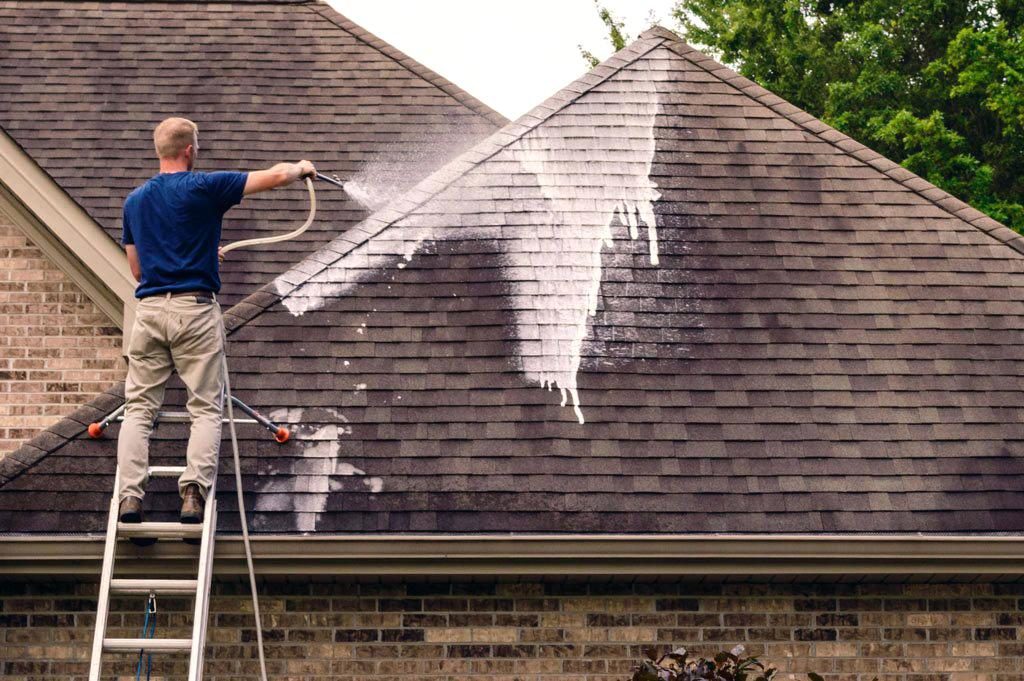
A mossy, streak-covered roof is an eyesore — and if you’re like many homeowners, your first instinct might be to blast it clean with a power washer. But before you fire up your machine, you should ask: Can I power wash my roof without damaging the shingles?
The answer: Power washing asphalt shingles is not recommended — at least not with high pressure. It can cause more harm than good. However, with the right method — specifically soft washing — you can clean your roof safely and effectively. Let’s walk through the risks, alternatives, and best practices. 🌤️🧽
🧱 Why Roof Cleaning Is Important
Over time, roofs accumulate:
- 🌿 Algae (especially Gloeocapsa magma, the black streaks)
- 🍃 Moss and lichen (which trap moisture)
- 🐦 Bird droppings and debris
- 🌬️ Dust, dirt, and pollen
Left untreated, these can:
- Shorten the lifespan of your shingles
- Cause water retention and rot
- Increase energy bills by reducing reflectivity
- Lower your home’s curb appeal 🏡
A clean roof isn’t just cosmetic — it’s essential for home maintenance.
⚠️ Why You Should Not Power Wash Asphalt Shingles
While power washing might seem like a quick fix, high-pressure water can:
- 💥 Strip away granules that protect your shingles from UV damage
- 🧱 Lift or crack shingles, especially older or brittle ones
- 🚫 Void your roofing warranty
- 💧 Force water underneath the shingles, leading to mold or rot
Even at relatively low pressure, a power washer can destroy thousands of dollars’ worth of roofing in minutes. 😱
🔄 The Safer Alternative: Soft Washing
Soft washing uses low-pressure water (under 500 PSI) combined with biodegradable cleaning agents to kill and lift stains.
Think of it as a roof “spa day” instead of a blast session.
✅ Safe for all types of roofing
✅ Removes moss, algae, and mold at the root
✅ Doesn’t damage shingles or underlayment
This is the method most professional roof cleaners use — and it’s what we recommend for homeowners too. 🧼
🧪 What’s in a Soft Wash Solution?
A typical soft wash formula includes:
- Sodium hypochlorite (bleach) – Kills algae, mold, and bacteria
- Surfactants – Help the solution cling to the roof surface
- Water – Dilutes and spreads the mixture evenly
After application, the solution is allowed to dwell for 15–20 minutes and then gently rinsed. The algae, moss, or streaks will disappear — often without scrubbing or blasting. ✨
🧰 What You’ll Need to Soft Wash a Roof
If you’re doing it yourself, gather:
- A low-pressure sprayer or garden hose attachment
- Roof cleaner (store-bought or homemade)
- A ladder and safety gear (harness, slip-resistant shoes)
- A long-handled brush (for stubborn moss)
- Lots of water for rinsing
- Plastic sheeting to protect landscaping 🌼
If climbing on a roof isn’t your thing, hire a pro — it’s safer and faster.
Browse Amazon Here For Soft Washing Equipment And Accessories
🧼 How to Soft Wash Your Roof (Step-by-Step)
- Inspect the roof for loose shingles or damage
- Protect landscaping by watering it or covering with plastic
- Mix your solution according to directions
- Spray the roof evenly using a low-pressure nozzle
- Let it dwell for 15–30 minutes
- Rinse gently with clean water
- Repeat if needed on heavily soiled areas
Note: Moss may take a few days to fall off after treatment. Don’t force it!
🌿 Preventing Future Growth
Once your roof is clean, take steps to prevent future algae and moss buildup:
- ✂️ Trim overhanging branches to increase sunlight
- 🌬️ Improve roof ventilation to reduce moisture retention
- 🧂 Install zinc or copper strips at the ridge — rainwater will carry ions that prevent algae and moss
- 📆 Schedule annual inspections to catch issues early
Prevention is always cheaper (and easier) than repeated cleaning. ✅
🧠 What About Other Roof Types?
| Roof Material | Safe to Power Wash? | Recommended Cleaning |
|---|---|---|
| Asphalt shingles | ❌ No | Soft wash only |
| Metal roofs | ✅ With caution | Low pressure + mild cleaner |
| Clay or concrete tiles | ❌ Usually not | Soft wash or gentle brushing |
| Slate roofs | ❌ Very fragile | Specialized soft cleaning |
Always check with your roofing manufacturer or installer before cleaning.
🛑 Common Mistakes to Avoid
- ❌ Using high pressure on shingles
- ❌ Letting bleach runoff hit plants (rinse them first and afterward)
- ❌ Skipping safety gear — roofs are slippery when wet
- ❌ Cleaning on hot, sunny days — solution can evaporate too quickly
- ❌ Not rinsing thoroughly — can leave streaks or residue
🏁 Final Thoughts
So, can you power wash your roof without damaging the shingles? Technically, yes — but only with the right approach. The safest method is soft washing, not high-pressure blasting.
If you care about your roof’s longevity, warranty, and appearance:
- 🚫 Avoid high PSI
- ✅ Use a soft wash technique
- 🧼 Apply eco-friendly cleaners
- 💧 Rinse thoroughly and protect your plants
Your roof protects everything underneath it — so treat it with care. Clean it the smart way, not the fast way. 🏠🛡️🌿
Browse Amazon Here For Soft Washing Equipment And Accessories






